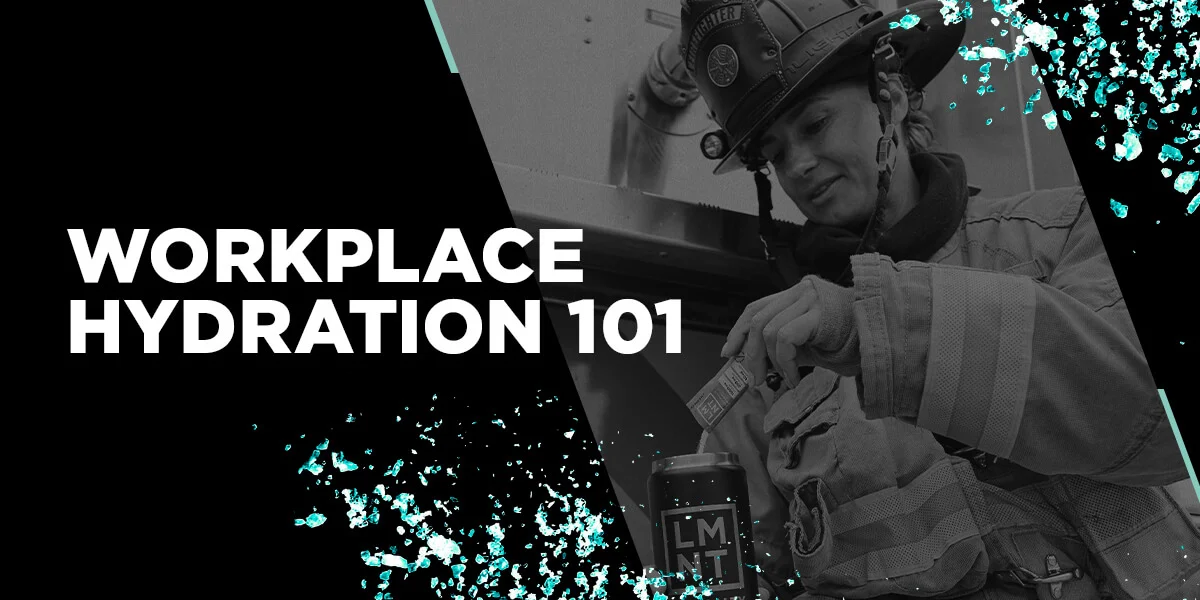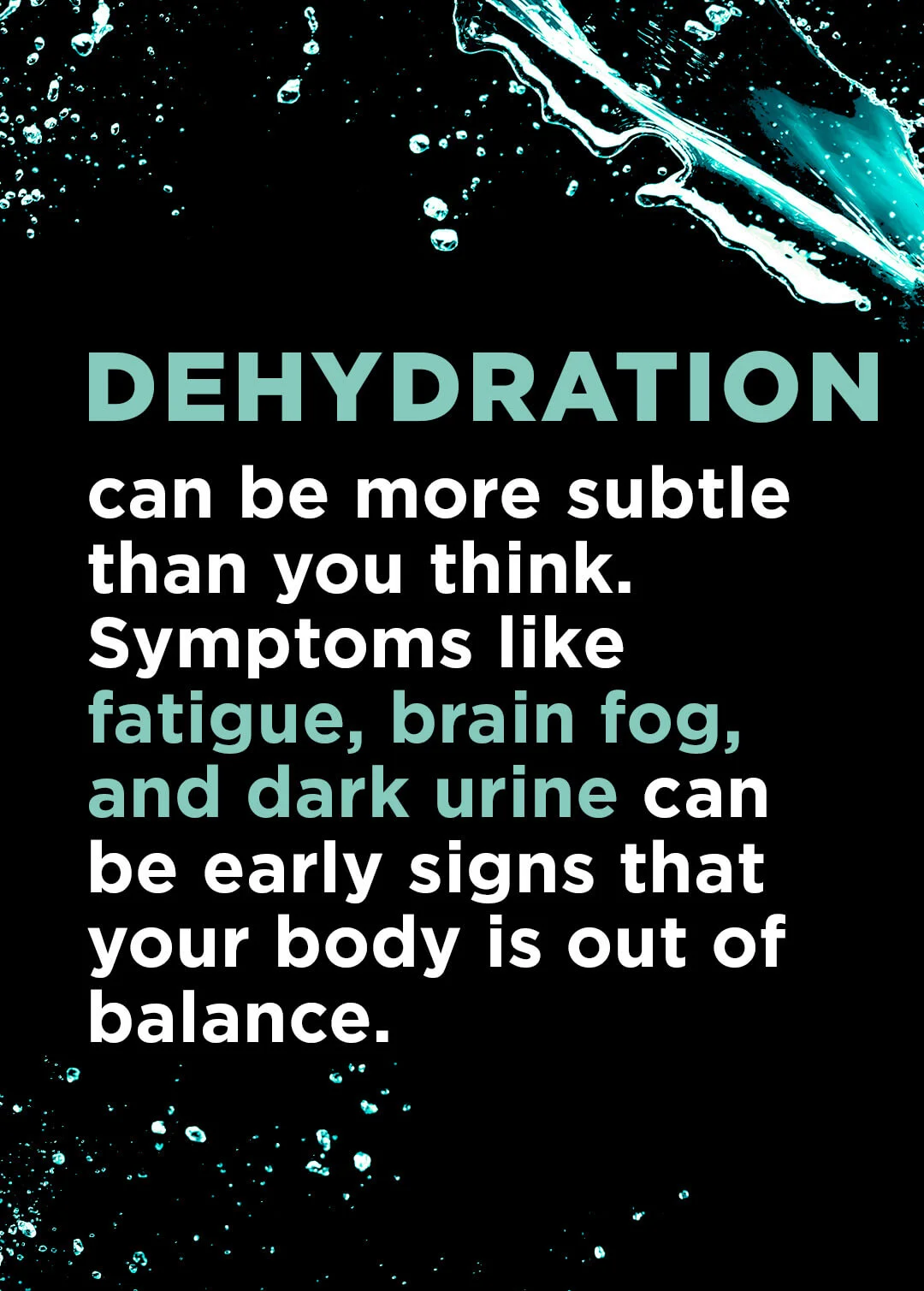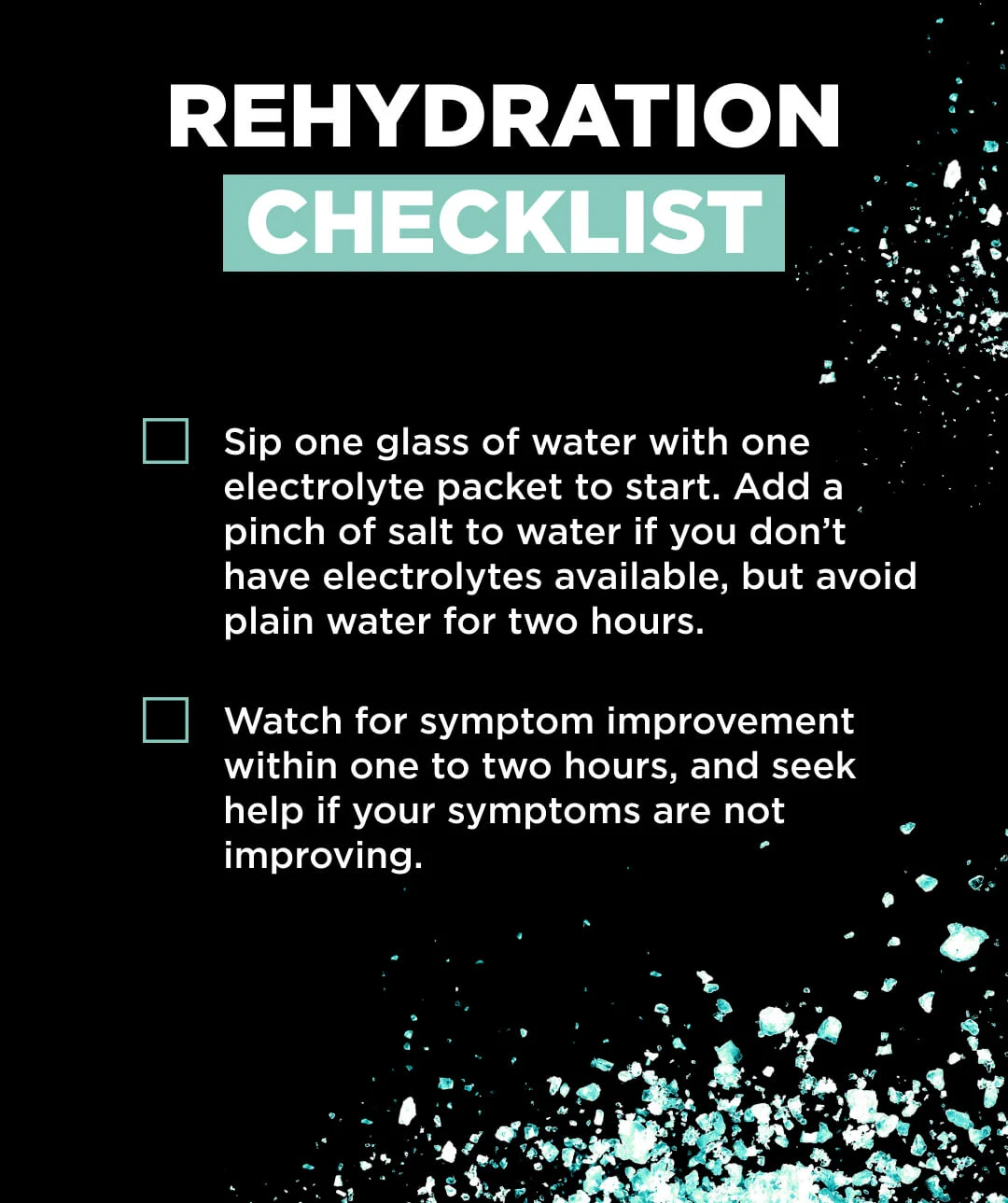
Workplace hydration 101 for industrial athletes in construction, firefighting, military, and more
Written by Kathleen Ferraro (opens in a new tab)
Medically reviewed by Ecler Ercole Jaqua, MD, MBA, DABOM (opens in a new tab) and Eliza Savage, MS, RD, CDN (opens in a new tab)
<p><strong>Industrial athletes — think firefighters, soldiers, construction workers, and others in high-output jobs — sweat hard. They lose sodium, potassium, and magnesium at levels that can affect focus, stamina, and safety. Staying sharp means hydrating with electrolytes, not just chugging water. Here’s what to know to keep yourself hydrated (and safe) on the job.</strong></p><p>Industrial athletes are workers whose daily output rivals that of traditional athletes. Climbing ladders in full gear, carrying loads on a hot site, or pulling long shifts in a warehouse demands the same physiological performance as an intense training session. And just like athletes, your hydration strategy can make or break your performance.</p><p>The problem: Most advice boils down to “just drink more water.” But for people who sweat gallons in heat and gear, that’s not enough. Losing sodium and other <a href="https://science.drinklmnt.com/electrolytes/what-are-electrolytes" rel="noopener noreferrer" target="_blank">electrolytes</a> without replacing them doesn’t just drain energy — it can slow reflexes, impair decision-making, and increase safety risks.</p><p>So how do you stay ahead of dehydration on the job? We asked the people responsible for keeping crews strong and safe.</p><h2>Who Are Industrial Athletes?</h2><p>The term “<a href="https://onlinelibrary.wiley.com/doi/full/10.1002/eat.24093" rel="noopener noreferrer" target="_blank">industrial athlete</a>” comes from occupational athletics, a field that applies the same principles used to train and support competitive athletes — strength, endurance, recovery, and injury prevention — to people whose jobs demand constant physical performance.</p><p>Industrial athletes aren’t training for game day. Their “event” is every shift. The physical demands are relentless, and often performed in extreme environments with little margin for error. Examples include:</p><ul><li>Firefighters carrying heavy loads of turnout gear while climbing multiple flights of stairs in smoke and heat.</li><li>Construction workers pouring concrete, operating at heights, or hauling equipment in hot climates.</li><li>Military personnel rucking with large amounts of gear for miles over rough terrain.</li><li>Warehouse and utility crews moving heavy loads on non-stop shifts, often in hot or poorly ventilated spaces.</li><li>First responders and law enforcement officers who may go from standing still to full-speed exertion in seconds.</li></ul>
<p>Like athletes, these workers rely on strength, stamina, sharp reflexes, and recovery.</p><p>For example, many general contractors perform heavy concrete self-perform work — moving, pouring, and finishing massive slabs — and often at elevated heights. “I think sometimes people can forget all the extensive manual labor can be exhausting over time,” says Zach Munro, safety manager at Brasfield & Gorrie, a construction company based in Birmingham, Alabama. “It is very important to start your day hydrated and stay consistent throughout.”</p><h2>Why Hydration Matters for Industrial Athletes</h2><p><a href="https://www.ncbi.nlm.nih.gov/books/NBK555956/" rel="noopener noreferrer" target="_blank">Dehydration</a> is more than dry mouth. It can impact cognition, coordination, and strength. Even mild fluid loss can impair focus, slow reaction times, and reduce muscular endurance. In high-stakes jobs like firefighting, construction, or military operations, those small lapses can have major consequences.</p><p>Extreme lethargy, dizziness, and heat stroke are the biggest risks related to heat and hydration in the construction industry, says Erik Perkins, co-owner of the <a href="https://www.perkinsbuilderbrothers.com/" rel="noopener noreferrer" target="_blank">Perkins Builder Brothers</a>, a construction company based in Bryson City, North Carolina. “Workers can go from being fine to not being fine very quickly,” he says.</p><p>On the job, that can mean:</p><ul><li>Slower reflexes when handling heavy equipment or responding to hazards</li><li>Poorer decision-making under pressure, which can escalate into safety incidents</li><li>Increased risk of musculoskeletal injury, as fatigued muscles are more prone to strain</li><li>Faster overall fatigue, which lowers productivity and morale across a crew</li></ul><p>And it’s not just anecdotal. Research on <a href="https://science.drinklmnt.com/did-you-know/hydration-for-medical-professionals/" rel="noopener noreferrer" target="_blank">medical professionals</a> — who also work long, high-pressure shifts — shows the ripple effects of dehydration. In one <a href="https://pubmed.ncbi.nlm.nih.gov/26216194/" rel="noopener noreferrer" target="_blank">study</a> of 88 on-call nurses and doctors, dehydration rates rose from 36 to 48 percent over the course of a single shift. Those who were dehydrated performed worse on short-term memory tests and showed declines across other measures of cognitive function. </p><p>The parallels are clear: Whether you’re in the hospital or on a job site, <a href="https://science.drinklmnt.com/electrolytes/how-to-stay-hydrated" rel="noopener noreferrer" target="_blank">hydration</a> isn’t optional when it comes to performance and safety.</p><p><a href="https://occup-med.biomedcentral.com/articles/10.1186/1745-6673-3-21" rel="noopener noreferrer" target="_blank">Research</a> also suggests that dehydration on the job is the norm. In hot, physically demanding conditions, construction workers can lose 0.3 to 1.5 liters of sweat every hour. This fluid loss can increase the risk of errors, injuries, and emergencies, so smart hydration has to be treated as part of the job, not an afterthought, says Munro.</p>
<h2>Electrolytes: Essential Fuel for Industrial Athletes</h2><p><a href="https://www.ncbi.nlm.nih.gov/books/NBK541123/" rel="noopener noreferrer" target="_blank">Electrolytes</a> are minerals (primarily sodium, potassium, and magnesium) that keep your body running under pressure. Here’s what they do: </p><ul><li>Sodium is a key player in fluid balance. Without enough, dizziness, poor coordination, and fatigue set in.</li><li>Potassium supports muscle contractions and heart rhythm. Too little leads to weakness, irregular heartbeat, and slower recovery.</li><li>Magnesium powers hundreds of cellular reactions, from energy production to muscle relaxation. Low levels can cause cramps, poor sleep, and irregular heartbeat.</li></ul><p>One <a href="https://pubmed.ncbi.nlm.nih.gov/18226265/" rel="noopener noreferrer" target="_blank">study</a> found that industrial athletes can lose 4.8 to 6 grams of sodium in a single shift. While this is an extreme case and far from universal, it’s true that in hot, high-output conditions, workers can lose several grams of sodium in a single shift. </p><p>“Without replacement, this can impair performance and raise safety risks,” explains Robb Wolf, former research biochemist, bestselling author, and co-founder of LMNT. “Replace only with water, and you may dilute blood sodium levels, potentially leading to <a href="https://www.ncbi.nlm.nih.gov/books/NBK470386/" rel="noopener noreferrer" target="_blank">hyponatremia</a> (dangerously low sodium).”</p><p>Put simply, for people working in heat, with heavy gear, or on prolonged shifts, electrolyte loss is a constant drain. Refueling with both fluids and electrolytes is essential to <a href="https://science.drinklmnt.com/electrolytes/electrolytes-and-energy" rel="noopener noreferrer" target="_blank">sustain energy</a>, mental clarity, and physical safety across an entire shift.</p><h2>Signs of Dehydration Industrial Athletes Should Watch For</h2><p><a href="https://science.drinklmnt.com/electrolytes/dehydration-causes-and-symptoms/" rel="noopener noreferrer" target="_blank">Dehydration</a> doesn’t always announce itself with extreme symptoms. More often, it builds gradually, usually from losing more fluids and electrolytes through sweat than you replace. </p><p>“When overheated, workers in my industry can get really lethargic and quickly feel depleted of all energy,” says Perkins. “If that happens, they have to try to hydrate and sit for a long time in the shade or air conditioning to recover.” </p><p>Early signs of dehydration include:</p><ul><li>Fatigue and sluggishness</li><li>Thirst</li><li>Dry mouth</li><li>Muscle cramps and weakness</li><li>Irritability or mood changes</li><li>Decreased urination</li></ul><p>More advanced signs of dehydration can escalate quickly, like:</p><ul><li>Dizziness or lightheadedness</li><li>Confusion</li><li>Poor coordination</li><li>Headaches</li><li>Nausea or vomiting</li><li>Heart palpitations</li><li>Cool, clammy skin, which may point toward the onset of heat exhaustion</li></ul><p>Here’s why this matters on the job:</p><ul><li>For a firefighter, dizziness or confusion inside a smoke-filled structure can compromise an entire team’s safety.</li><li>For a construction worker on scaffolding or operating machinery, slower reflexes and poor coordination raise the risk of falls and accidents.</li><li>For military personnel in the field, fatigue and cognitive decline can impair mission readiness.</li><li>For warehouse and utility crews, muscle cramps or lapses in focus can lead to strains, missed steps, or equipment mishandling.</li></ul>

<h2>Hydration Strategies for Peak Performance on the Job</h2><p>For industrial athletes, the best results come from treating hydration like part of the job: prepare before your shift, maintain during, and replenish after. Here’s what to keep in mind: </p><ul><li><strong>Before your shift:</strong> Start the day hydrated with <a href="https://pmc.ncbi.nlm.nih.gov/articles/PMC8336541/" rel="noopener noreferrer" target="_blank">16 to 20 ounces</a> of water with electrolytes. Think of this as loading fuel before a long drive — you don’t wait until the tank is empty. “We may be in a good flow or high up on scaffolding, which aren't necessarily situations conducive to hydrating,” says Perkins. “Something that helps is coming into the day already hydrated instead of trying to hydrate after overheating.”</li><li><strong>During your shift:</strong> If possible, sip consistently instead of chugging occasionally, says <a href="https://www.instagram.com/matt1chan/" rel="noopener noreferrer" target="_blank">Matt Chan</a>, a fire training cadre member in Colorado. Set reminders to drink every 15 minutes, especially in hot conditions or when wearing heavy gear. Pair your fluids with electrolytes like <a href="https://drinklmnt.com/" rel="noopener noreferrer" target="_blank">LMNT</a> to replace what you’re sweating out.</li><li><strong>After your shift:</strong> Recovery is just as important as preparation. Replace fluids and sodium lost during the day to reduce muscle soreness, improve sleep, and prepare for tomorrow.</li></ul><p>Chan saw firsthand how quickly firefighters can sweat out half a gallon in just 30 minutes of live fire training. Adequate hydration reduces the risk of heat-related illness and can help lower the likelihood of exertional <a href="https://science.drinklmnt.com/did-you-know/rhabdomyolysis/" rel="noopener noreferrer" target="_blank">rhabdomyolysis</a> (a condition that causes your muscles to break down dangerously quickly), though workload management and rest are also critical factors. </p><p>To cut down on heat injuries, Chan and his team developed a simple protocol that applies to anyone working in high heat or high gear (note that these are not medical guidelines, but rather an on-the-job tip used by Chan and firefighters sharing their real-life experience).</p><ul><li><strong>Step 1:</strong> Divide your bodyweight by 2. That number is your baseline fluid need (think plain water) in ounces per day — your no-excuses minimum.</li><li><strong>Step 2:</strong> Divide your bodyweight by 30. That number is your electrolyte water target in ounces every 15 minutes of heavy exertion. Multiply by 4 to get your hourly intake.</li></ul><p>For example, let’s say you weigh 180 pounds. You’d start by dividing your bodyweight by two to get your baseline fluid needs: 180 ÷ 2 = 90 ounces of plain water per day.</p><p>Next, divide your bodyweight by 30 to find your electrolyte target: 180 ÷ 30 = 6 ounces of electrolyte water every 15 minutes of heavy exertion.</p><p>If you’re working hard for four hours, that’s 16 fifteen-minute blocks. Multiply 6 ounces by 16 to get 96 ounces of electrolyte water.</p><p>In total, when following this firefighter protocol, you’d aim for 90 ounces of plain water plus 96 ounces of electrolyte water — about 186 ounces of fluids for the day.</p><p>“When you work, you sip,” says Chan. “When you sweat, you salt.” It’s a straightforward system designed to protect both health and <a href="https://science.drinklmnt.com/did-you-know/performance-hydration/" rel="noopener noreferrer" target="_blank">performance</a> on the job.</p>
<h2>Hydration Myths and Mistakes to Avoid</h2><p>A lot of common hydration advice is outdated or flat-out wrong. These myths and mistakes can leave industrial athletes drained, foggy, and more vulnerable to heat-related illness.</p><p>Common myths include: </p><ul><li><strong>Only athletes or outdoor workers need to think about sodium.</strong> In reality, anyone working hard in gear, heat, or long shifts can sweat out significant amounts of sodium.</li><li><strong>If I’m not thirsty, I’m hydrated. </strong>Thirst can be a lagging signal, so you’re already behind by the time it kicks in.</li><li><strong>Sports drinks are effective electrolyte replacements. </strong>Some commercial sports drinks can help replace electrolytes, but many are overloaded with added sugars. Look for lower-sugar options or dedicated electrolyte mixes.</li><li><strong>Muscle cramps mean I need more potassium. </strong><a href="https://link.springer.com/article/10.1007/s40279-019-01162-1" rel="noopener noreferrer" target="_blank">Sodium loss</a> is the primary culprit behind cramping, not just potassium.</li><li><strong>Hydration isn’t as important in cold-weather environments. </strong><a href="https://pmc.ncbi.nlm.nih.gov/articles/PMC5042416/" rel="noopener noreferrer" target="_blank">Cold reduces thirst cues</a>, but sweat and fluid loss can still continue under heavy layers and strenuous work.</li><li><strong>Fatigue just means I need more sleep or caffeine.</strong> Sometimes, fatigue is your body flagging dehydration or low sodium.</li></ul><p>Here are some common mistakes to look out for: </p><ul><li><strong>Skipping pre-hydration before long or hot shifts.</strong> Starting behind makes it harder to catch up.</li><li><strong>Waiting until thirst hits to hydrate. </strong>Hydration needs to be steady and proactive.</li><li><strong>Over-relying on caffeine or energy drinks during shifts.</strong> These don’t always adequately replace electrolytes. And because caffeine can <a href="https://www.sciencedirect.com/science/article/pii/S2772417424000104" rel="noopener noreferrer" target="_blank">increase urination</a>, it can worsen fluid loss if you’re not proactively hydrating.</li><li><strong>Going multiple hours without fluid intake during long shifts.</strong> Even light sipping is better than big gaps.</li><li><strong>Avoiding salt altogether due to general health concerns. </strong>Sodium is essential for performance and safety on the job.</li></ul>

<h2>Practical Tips to Implement Effective Workplace Hydration Programs</h2><p>For leaders managing crews of industrial athletes, hydration should be a workplace safety protocol. A well-hydrated team is sharper, stronger, and less likely to suffer preventable injuries. Here are a few strategies that make a difference:</p><ul><li><strong>Encourage regular hydration breaks: </strong>Munro emphasizes the importance of consistent hydration throughout the day. Build breaks into the schedule the same way you would tool checks or safety huddles to reduce the risk of fatigue stacking up over time.</li><li><strong>Provide easy access to electrolyte-enhanced fluids on job sites: </strong>Water alone doesn’t cut it when workers are sweating out liters of fluid and grams of sodium. Stocking electrolyte mixes like <a href="https://drinklmnt.com/" rel="noopener noreferrer" target="_blank">LMNT</a> at refill stations ensures crews replace what they’re actually losing.</li><li><strong>Educate teams on recognizing dehydration early:</strong> Make sure everyone knows the signs and feels empowered to act quickly, says Munro. A short talk during a safety meeting or a posted checklist at the site can help normalize hydration as part of the job.</li><li><strong>Leverage crew-wide programs: </strong><a href="https://drinklmnt.com/pages/giveasalt" rel="noopener noreferrer" target="_blank">LMNT’s Give a Salt program</a> provides free product and a hydration safety poster for teams of industrial athletes. It’s a simple way to reinforce the message and make sure hydration protocols stick.</li></ul><p>When employers take hydration seriously, the <a href="https://science.drinklmnt.com/did-you-know/hydration-benefits" rel="noopener noreferrer" target="_blank">benefits</a> are clear: fewer heat-related illnesses, higher morale, and improved job performance.</p><p>“When it's hot and humid outside, electrolytes are a must. When my crew is adequately hydrated, we are much more productive and energetic,” says Perkins. “There is also less of a chance that someone will have to take an extended break or worst case, go to the hospital for heat exhaustion or a heat stroke.”</p><h2>Key Takeaways</h2><ul><li>Industrial athletes (like firefighters, soldiers, construction crews, and more) perform at the same physiological level as sports athletes, and their hydration needs are just as critical.</li><li>Water alone isn’t enough. Sweat contains sodium, potassium, and magnesium, and losing these electrolytes without replacing them can impair focus, stamina, and safety.</li><li>Dehydration builds gradually and can cause fatigue, slower reflexes, poor decision-making, or cramps even before thirst sets in.</li><li>Proactive hydration works best: Prehydrate before shifts, sip electrolytes steadily during work, and replenish afterward.</li><li>A useful rule of thumb some crews use is bodyweight ÷ 2 in ounces of fluids per day as a baseline. During heavy exertion, aim for ~4–8 ounces of electrolyte fluids every 15–20 minutes. Exact needs vary widely, so adjusting based on sweat rate, climate, and medical guidance is important.</li></ul><h2>Frequently Asked Questions (FAQs)</h2><h3>What is an industrial athlete?</h3><p>An industrial athlete is anyone in a physically demanding job (like construction, firefighting, military service, law enforcement, or warehouse work) whose daily output rivals that of sport athletes. Their performance, safety, and recovery all depend on conditioning, nutrition, and hydration.</p><h3>What is the best hydration for industrial athletes?</h3><p>The best hydration strategy is a cycle of before, during, and after your shift. Pre-hydration sets you up for the day with fluids. During work, steady sipping with electrolytes replaces the liters of sweat and grams of sodium you lose on the job, keeping fatigue, cramps, and brain fog at bay. Post-shift, replenishing fluids and sodium supports recovery, reduces soreness, and prepares you for the next day.</p><h3>What are the best fluids for hydration?</h3><p>Electrolyte water or mixes are the gold standard, since they replace both fluids and sodium. Plain water helps, but in high-heat and high-output conditions, it should be balanced with electrolytes to avoid diluting sodium levels in the blood.</p><h3>How do you stay hydrated in the workplace?</h3><p>Start the day hydrated, sip consistently throughout your shift, and replenish electrolytes afterward. Employers can help by scheduling hydration breaks, stocking electrolyte options on-site, and educating crews on early signs of dehydration.</p><h3>What is the best thing to drink when working in the heat?</h3><p>A mix of water and electrolyte water is best. Workers in hot conditions can lose liters of sweat every hour, so fluids must replace both water and sodium. Sports drinks typically contain unnecessary amounts of added sugars, and plain water isn’t enough on its own.</p><h3>What are the OSHA rules for hydration?</h3><p>The <a href="https://www.osha.gov/sites/default/files/publications/OSHA4372.pdf" rel="noopener noreferrer" target="_blank">Occupational Safety and Health Administration</a> (OSHA) requires employers to provide safe, potable drinking water and to implement heat illness prevention measures (like rest breaks, shade, and training). While they do not mandate electrolyte replacement, many safety experts recommend including electrolyte options for crews working in high-heat or high-output conditions.</p><h3>How can I supply LMNT to my workforce?</h3><p>Join our LMNT Wholesale Program to get the best bulk pricing on LMNT and keep your crew going strong — for the construction and field crews, tradesmen, logistics operators, and other hands-on pros. Apply at <a href="http://drinklmnt.com/wholesale" rel="noopener noreferrer" target="_blank">drinklmnt.com/wholesale</a>.</p>
